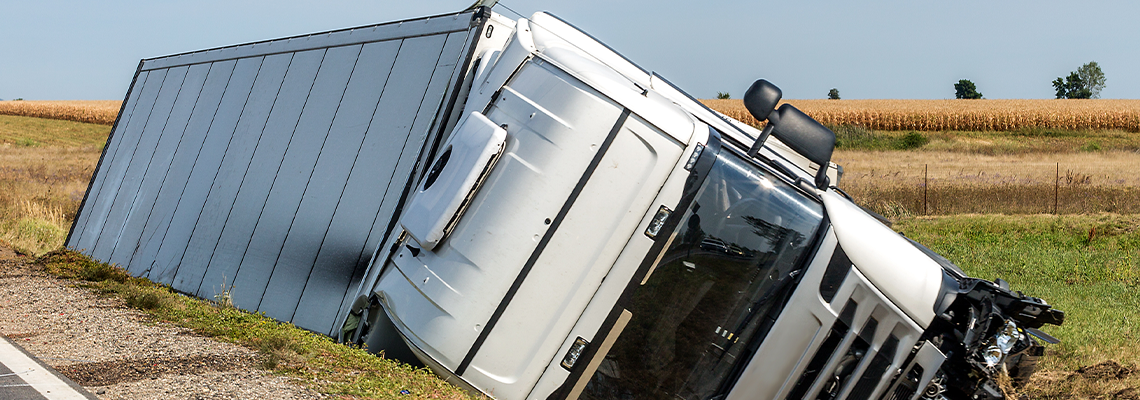
How Blind Spots in Commercial Trucks Contribute to Accidents and Liability Issues
When drivers can’t see other vehicles or pedestrians in critical zones around their rigs, collisions can happen in an instant. Recognizing how blind spots in commercial trucks contribute to accidents and liability issues helps you understand your rights and the evidence you’ll need to prove fault.
At The Eskesen Law Firm in New York, I represent victims who have been injured in collisions with commercial trucks. Whether you’ve been hit in an intersection, squeezed on the highway, or injured during a lane change, I can help you understand the causes of these crashes and how New York law holds negligent parties accountable.
Blind Spots in Commercial Trucks
All vehicles have blind spots. However, commercial trucks have larger blind spots than passenger vehicles due to their height and length. These “no-zone” areas typically include the sides, front, and rear of the truck, where the cab, trailer, or blind-spot mirrors obstruct the driver’s view.
Since blind spots in commercial trucks can extend up to 20 feet in front and 30 feet behind, smaller vehicles or pedestrians can disappear from the driver’s sight, increasing the risk of side-impact and rear-end collisions. Truck design, mirror placement, and lack of auxiliary cameras all impact how extensive these danger zones can be.
Common Commercial Trucking Accidents Involving Blind Spots
Although commercial trucks must use mirrors and warning devices, these vehicles still have no-zone areas where drivers can’t see other road users. When these blind spots overlap with traffic patterns, collisions can easily occur. Some of the most common types of accidents resulting from commercial truck blind spots include the following.
Side-impact collisions: A car alongside the truck’s passenger side is struck when the driver drifts from the blind spot during a lane change.
Right-turn crashes: Pedestrians or cyclists on the curbside are hit when a truck turns right without detecting them in the blind zone.
Rear-end collisions: Vehicles braking ahead are struck because the driver loses sight of slowing traffic behind the trailer.
Merging accidents: Drivers entering highways collide with trucks when their vehicle moves into the driver’s blind spot as the truck switches lanes.
By mapping these common patterns, accident reconstruction professionals can chart the exact sequence of events to show how reduced visibility led to the impact. An experienced attorney can help you gather targeted evidence and present a compelling case for liability.
Insurance Considerations in Blind Spot Claims
When a blind-spot collision occurs, insurers are required to establish coverage and fault before settling any claim. Understanding how liability is apportioned and what your policy covers is essential to maximizing recovery.
Coverage types: Liability, uninsured motorist, and underinsured motorist policies may all apply depending on fault and the other driver’s insurance status.
Fault apportionment: Your insurer will examine police reports, witness statements, and accident reconstruction to assign percentages of fault among involved parties.
Policy limits: Each policy has maximum payout amounts; knowing these limits helps you evaluate whether you need to pursue additional defendants.
Claim investigation: Insurers may request recorded statements, medical exams, and equipment inspections to verify the extent of damage and injuries.
Notify all insurers promptly, provide accurate information, and challenge lowball offers to protect your right to full compensation. Working with a personal injury lawyer can help you combat insurer tactics don’t undermine the value of your claim.
Legal Liability for Blind Spot–Related Accidents
Assigning fault in a blind-spot collision often involves more than just the truck driver. Under New York law, trucking companies, equipment manufacturers, and maintenance providers may share responsibility when safety devices fail or training falls short. Determining who’s liable requires tracing the following factors that led to the accident.
Truck driver: Failing to check mirrors, signal properly, or maintain safe following distances
Trucking company: Negligent hiring, inadequate driver training, or lack of mandated safety equipment on the rig
Vehicle manufacturer: Defective mirror design, flawed camera systems, or poor placement of auxiliary visibility tools
Maintenance provider: Misaligned mirrors, malfunctioning sensors, or neglected repairs that expanded no-zone areas
Uncovering each party’s role relies on a detailed review of the maintenance logs, training records, and equipment specifications. A clear attribution of liability allows you to hold all responsible parties accountable to maximize your recovery.
Federal Regulations Governing Visibility Equipment
The Federal Motor Carrier Safety Administration requires specific mirror configurations under 49 CFR § 393.80. These require rear-vision, convex, and cross-view mirrors to be positioned to cover critical blind-spot zones. These standards mandate minimum mirror sizes, mounting heights, and angles to create overlapping fields of vision.
Regular compliance audits and inspections can help enforce these rules, and carriers can face penalties or out-of-service orders for violating these laws. Maintaining inspection reports, retrofit documentation, and maintenance logs is essential for proving whether a truck met federal visibility requirements at the time of an accident.
Steps to Take After a Blind Spot Accident
If you've been involved in a blind spot accident with a commercial truck, it's important to take immediate action to preserve critical evidence and strengthen your claim. To capture the full scope of the incident, take the following steps:
Document the scene: Photograph the vehicle positions, mirror angles, road markings, and any debris before anything’s moved.
Get witness information: Collect the names, contact details, and written statements from bystanders or other drivers who witnessed the crash.
Seek medical attention: Obtain prompt treatment from a licensed medical professional and retain all records of diagnoses, prescriptions, and follow-up care.
Preserve truck records: Request inspection reports, maintenance logs, and the driver’s training files to check for safety feature failures.
Documenting the conditions at the scene, securing eyewitness accounts, and obtaining timely medical records all serve as building blocks for proving fault. By taking these actions, you, your attorney, and any investigators can demonstrate how blind spots contributed to your injuries.
Contact Me at The Eskesen Law Firm Today
If you’ve been hurt in a blind spot accident with a commercial truck, you have the right to pursue compensation for medical expenses, lost wages, and pain and suffering. At The Eskesen Law Firm, I am committed to standing up for your rights and handling your case so you can focus on what matters most: your recovery.
Located in New York, New York, I serve clients throughout New York County, Kings County, Queens County, Bronx County, Richmond County, Westchester County, and Rockland County. Contact me today to schedule a free consultation.
